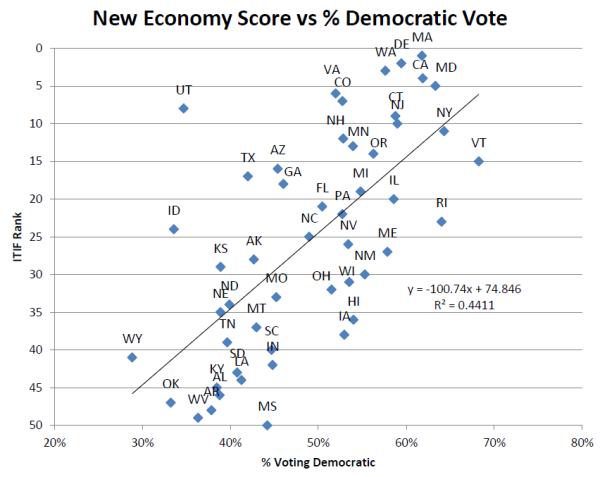Wisconsin Lags in Building a High Tech Economy
Which states and cities lead the way in building a new economy? Part I of a three-part series.

Computer Chip. Image from the University of Iowa.
Of the two generic business strategies–cost leadership and differentiation—Wisconsin’s current efforts at business development mostly fit the cost leadership mold. This approach depends on attracting companies through low tax rates and business-friendly regulations. In recent years this strategy has been heavily promoted by a number of well-funded organizations, in Wisconsin and nationally. A win for this approach is the recent decision by Amazon to create a distribution center in Kenosha, motivated in part by government subsidies and the prospect of serving the Chicago market without paying Illinois’ sales tax.
The other approach, a differentiation strategy, looks to differentiate oneself from competitors by offering a unique value to the customer, ideally something that’s hard for competitors to copy. On a state level, attempting to build a high-tech innovative economy is an example of a differentiation strategy that could have a major impact for Wisconsin. Two organizations that do research and publish studies about building a high-tech economy are the Information Technology & Innovation Foundation (ITIF) and Kansas City’s Kauffman Foundation. Although starting from somewhat different positions, their conclusions are remarkably consistent.
The Kauffman Foundation has published several studies analyzing job growth. It finds that net job growth in the US can be attributed entirely to high-tech startups in recent years. In fact, large mature firms have destroyed more jobs than they created. As a group, startups outside the high tech areas create few jobs according to Kauffman. Kauffmann’s High-Tech Startup Density index rates metropolitan areas using the ratio of high tech startups—in industries with very high proportion of employees in science, technology, engineering, and math. The ratio of each city’s density to the national average is then calculated.
Although based on different information, the two rankings tend to come up with similar results. Metropolitan areas ranked highly by Kauffman are likely to be in states ranked highly by ITIF. In both the highest ranked states and cities are concentrated in the Northeast, around the nation’s capital, along the Pacific and in the Rocky Mountains. With a few exceptions, the southeast cities and states fare poorly. Most of the Midwest falls in the middle.
In both the the Kauffman and ICT rankings of high-tech startup density, a city like Boulder ranks the highest, at about 4, while the lowest ranked cities would have a density of zero. The national average is 1, but most big cities surpass this while small cities and towns rank below it. Except for Madison, all Wisconsin’s cities score below the national average. The overall scores of the state’s two largest cities—Milwaukee (which includes Waukesha) and Madison–both declined between 1990 and 2010, as did most other Wisconsin cities.
| Wisconsin Cities Growth or Decline in High-Tech Startup Density | Kaufmann Ranking | ICT Ranking | ||
| 1990 | 2010 | 1990 | 2010 | |
| Madison, WI | 1.4 | 1.0 | 1.2 | 1.1 |
| Racine, WI | 0.7 | 0.8 | 0.4 | 0.6 |
| Green Bay, WI | 0.1 | 0.6 | 0.0 | 0.6 |
| Milwaukee-Waukesha-West Allis, WI | 1.0 | 0.6 | 0.9 | 0.7 |
| Appleton, WI | 0.4 | 0.5 | 0.2 | 0.5 |
| Oshkosh-Neenah, WI | 0.4 | 0.4 | 0.2 | 0.4 |
| Janesville, WI | 0.1 | 0.3 | 0.0 | 0.3 |
| Eau Claire, WI | 0.4 | 0.2 | 0.1 | 0.2 |
| Sheboygan, WI | 0.8 | 0.2 | 0.7 | 0.1 |
| La Crosse, WI-MN | 0.4 | 0.2 | 0.2 | 0.1 |
| Fond du Lac, WI | 0.4 | 0.1 | 0.0 | 0.2 |
| Wausau, WI | 0.4 | 0.1 | 0.0 | 0.1 |
Even Wisconsin’s standout, Madison, while outperforming the rest of the state, fell below many of its university-town peers, particularly Boulder. One Kauffman report found that Madison had the 5th largest decline among mid-large metropolitan areas in high-tech startup densities between 1990 and 2010.
ITIF’s New Economy Index ranks Wisconsin as 31st among the states. On most of the 26 indicators, Wisconsin falls somewhere in the middle. Kaufmann doesn’t rank states.
Why are some states and cities hotbeds of innovation and high-tech startups while others lag behind? Two factors stand out: a tolerance for odd ideas and a lifestyle attractive to “nerds” and investors.
-A tolerance for odd ideas. In a provocative essay titled How to be Silicon Valley, the Silicon Valley investor Paul Graham argued there was a “connection between technology and liberalism. Without exception the high-tech cities in the US are also the most liberal. But it’s not because liberals are smarter that this is so. It’s because liberal cities tolerate odd ideas, and smart people by definition have odd ideas. Conversely, a town that gets praised for being ‘solid’ or representing ‘traditional values’ may be a fine place to live, but it’s never going to succeed as a startup hub.”
It’s noteworthy that the two states recently in the news for legalizing marijuana are also near the top of the ITIF New Economy list—Washington at third and Colorado at seventh. The same pattern holds when other social issues are considered: states proposing further restrictions on contraception or abortion, for instance, predominantly fall near the bottom of the New Economy rankings and their cities tend to have low high-tech densities.
Expanding on Graham’s argument about the connection between tolerance and liberalism, the scatter plot below compares ITIF’s New Economy Index with percentage voting Democratic in the last presidential election. You can see that many of the states that have a high ITIF rank on the vertical scale (lower values are better) voted by 50 percent or more (as measured on the horizontal scale) for the Democratic candidate in 2012. Those with a low percentage vote for the Democrat tend to be clustered toward the bottom of the ITF rankings. To compensate for personal connections between a state and one of the candidates, I used 2008 results for Utah and 2004 results for Hawaii. Statistically, the relationship is strong, explaining 44 percent of the variation and with a p-value under .0001.
A correlation coefficient of .66, however, still allows for considerable scatter. Unfortunately for Wisconsin, it scatters in the wrong direction, coming in 31st, rather than a predicted 22nd place if it was consistent to the model.
The Kauffmann results also find a similar pattern. Of the 25 metropolitan areas with highest high-tech startup density, 16 were in states that voted Democratic and 17 in counties that voted Democratic.
-An attractive lifestyle. Parks, bicycle trails, and other amenities are often derided as frivolities, to be funded only after more practical necessities are taken care of. The counter view is that these have become requirements of economic success by attracting the people with technical strengths. As Graham argues, talking about the sort of people who start, work in, or fund the companies in Silicon Valley, “they like well-preserved old neighborhoods instead of cookie-cutter suburbs, and locally-owned shops and restaurants instead of national chains….. they want to live somewhere with personality…. Most towns with personality are old, but they don’t have to be. Old towns have two advantages: they’re denser, because they were laid out before cars, and they’re more varied, because they were built one building at a time.”
Enterprises are becoming increasingly less dependent on proximity to raw materials and much more dependent on being in places where people want to live. Advocates of this model can point to the success of cities like Portland, famous—and much mocked—for emphasizing amenities like light rail and bicycle friendliness. Portland, in fact, was missing entirely from Kauffman’s 1990 list of the top 20 large cities for high-tech startup densities, but placed eleventh on the list for 2010. There is a strong statistical correlation between the League of American Bicyclists’ ranking of states for bicycle-friendliness and the ITIF New Economy rankings.
A recent report from the entrepreneurial-support organization Endeavour surveyed 150 founders of high-growth companies to see what they wanted in a city. The survey found that the entrepreneurs chose a city years before starting a company based on the quality of life and personal connections. Once the company was started in a city, it stayed put. The most important resource mentioned was a pool of talented employees. Only 5 percent mentioned low tax rates and 2 percent business-friendly regulations as reasons for starting businesses in a specific city.
A century ago Wisconsin prospered by building companies that were on the forefront of the technology of the time. Little of the state’s prosperity depended wooing companies here from other states, on branch plants and distribution centers attracted by low costs. So in some ways building a high-tech economy is returning to Wisconsin’s roots. With its progressive traditions, the state should be matching Minnesota, yet it is lagging behind. In future articles I plan to explore possible reasons why.
Data Wonk
-
Why Absentee Ballot Drop Boxes Are Now Legal
 Jul 17th, 2024 by Bruce Thompson
Jul 17th, 2024 by Bruce Thompson
-
The Imperial Legislature Is Shot Down
 Jul 10th, 2024 by Bruce Thompson
Jul 10th, 2024 by Bruce Thompson
-
Counting the Lies By Trump
 Jul 3rd, 2024 by Bruce Thompson
Jul 3rd, 2024 by Bruce Thompson






















Another stellar article! The darn JSOnline should be reprinting this stuff… it’s almost a case in point that they don’t!
This should be required reading and comment by every elected official and candidate for office in Wisconsin. Nerds rule! and I’m not sure I understood all the technical aspects but economies are founded by weirdo’s like Henry Ford who came up with the assembly line and Thomas Edison. it seems like the conclusion is those who think outside the box want to live outside it also?
It’s time for Milwaukee, Madison and Chicago to band together to form a real economic region, brand it as Great Lakes West or Rust Best Plus (ok, maybe not) or the MMC Region. Similar to the Bay Area in California or the Golden Triangle in Colorado, we’d be able to market our region as having talented hard working people ready to do business. Chicago gives us the international presence (San Francisco), the innovative culture provided by major universities most notable is UW-Madison (Berkeley) and hard working and artistic people of Milwaukee (Oakland).
We will continue promoting Milwaukee’s roots in urban farming and fresh water initiatives. Everyone has to eat and drink. How about Madison’s research and advances in medicine and technology? That covers two of the largest industries today. Chicago sells itself and is a hybrid of everything Milwaukee and Madison are involved with. As utilities are generally a safe investment due to providing an essential need, everyone needs what our MMC region can offer.
MMC action would create jobs at all levels, from construction of buildings, transportation systems (we need trains), middle class jobs and the company leadership positions. And as more leaders are attracted to the MMC region, it opens up for higher volume of travel, important for restaurants, hotels, bars, etc.
I lived in Milwaukee for the first 36 years of my life and have temporarily relocated to the Bay Area. There is no reason Milwaukee, Madison and Chicago can’t duplicate what is going on in California. We need greater transparency between the MMC cities and make it possible for businesses to set up shop with tax breaks or incentives. You could make the argument that it’s going to be expensive and I would agree. The fact remains our region is missing out on exciting business opportunities that bring jobs and higher quality of life.
I think Wisconsin is doing a fine job differentiating itself. We’re open for business after all. If you’re an old line, conservative, mostly white male driven business that prefers low wages we’re here for you. If you’re part of the creative class? Well, you’re all sinners in the eyes of god so who needs you anyway. IT’S WORKING!
What could be more high tech than a trolley? Or a crumbling City Hall? Clearly the creative enterprising types are just intimidated by Milwaukee’s bold and dynamic leadership, relentless in its pursuit of excellence!
Great article. I think regionalism is important, and in response to the regional alliance comment here is an interesting quote (although it doesn’t include Madison, it is referring to the Milwaukee – Chicago – Gary corridor.): “At issue is its extreme fragmentation… The Greater Toronto Area has 28 local and city gov entities. Greater London has 34. The Paris metro-region, one of the most fragmented in the OECD, has nearly 1,400. The Chicago tri-state region has 1,700 distinct units… there is no inherent disadvantage in having small local government units…. but proliferation on this scale sometimes leads to myopic decisions, while area-wide consensus and long-term strategic thinking become difficult…” Although something consider and not stated there is the difference in geographic size between the regions. Comparison between regions in US is helpful, like above, distance between SF and San Jose is only 20mi less than Mke to Madison. If you haven’t yet, you might be interested in checking out the OECD report and the subsequently formed Alliance for Regional Development. http://chicagolandchamber.org/wdk_cc/programs_and_advocacy/tri-state_alliance.jsp
@over the air
First of all, modern streetcar systems are more technologically advanced than buses… sooooo wrong.
Urban agriculture and freshwater technology, both areas of huge importance on an international level and both industries that involve new, advanced technology.
What the mistakes of a contactor for the repair of City Hall’s terra cotta has to do with this discussion, I’m not even going to attempt to touch.
Some very interesting comments. Milwaukee and Wisconsin are not alone in lagging. The problem is true of most of the Midwest (with the possible exception of the Twin Cities). Just be happy we aren’t in the South. This makes me think that the problem is much more a cultural one than due to a particular state government. I hope to explore possible causes in future articles.
An additional factor that I believe makes it particularly challenging for Wisconsin versus other states, including those in the Midwest, is that none of our metro areas have the critical mass necessary to be a destination locale. The Twin Cities are more than twice the size of Milwaukee from a population standpoint, and have the job base to attract entrepreneurs and job-seekers, and keep graduates.
Excellent article. Also keep in mind that the Twin Cities and MN are more progressive than the current Wisconsin state government. The Twin Cities emphasize and value public recreation and have an excellent bike trail system, an expanding light rail system and a Democratic governor who didn’t create a crisis to pit citizens against one another. Milwaukee is trying to catch up to the Twin Cities with little help or support from state government. For example, instead of building for the future and including a bike lane on the Hoan bridge, our Dept. of Transportation in its wisdom refused to do so, despite ample support and solid reasons to build the bike lane. Gov. Walker and his vision for the state are looking to the past; let’s hope in November 2014 we can look forward.